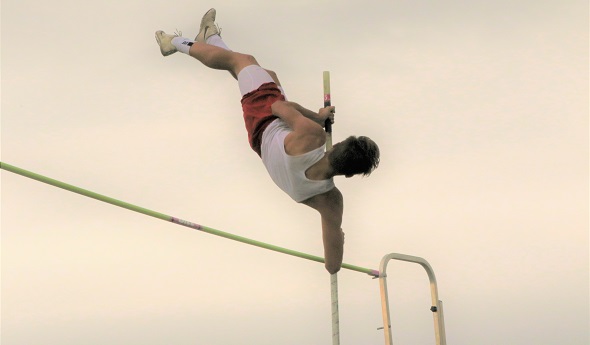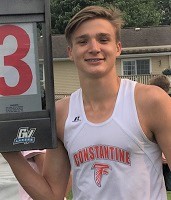
Alwine's Risk Rewarded with Top Vault
By
Wes Morgan
Special for MHSAA.com
June 5, 2019
Wyatt Alwine was one more failed attempt away from having a very bad day at last Saturday’s MHSAA Lower Peninsula Division 3 Track & Field Finals.
 With some of his adrenaline reserve drained from a long rain delay, the Constantine junior — seeded No. 1 entering the meet — described himself as a “mental case” after having missed his first two tries at an opening height of 12 feet, 3 inches, one of which ended in the grass.
With some of his adrenaline reserve drained from a long rain delay, the Constantine junior — seeded No. 1 entering the meet — described himself as a “mental case” after having missed his first two tries at an opening height of 12 feet, 3 inches, one of which ended in the grass.
After finishing third overall for all-state status a year earlier, Alwine was in danger of not posting a height at all.
“My head just wasn’t there,” he said. “The rain delays didn’t help. I think that was one of the main reasons for a lack of focus.”
A calming influence for Alwine throughout the storms was first-year Constantine pole vault coach Stephanie Teeple — a past three-time Finals champion at Sturgis (1998, 2000, 2001) who went on to do big things at the University of Nebraska and Western Michigan University, including breaking the WMU outdoor record. She always could count on her coach and father, Wes Teeple, who set a school record at Eastern Michigan University and won two league titles, and her mother, Cheryl, who also coached at Sturgis. Oh, and there was older brother Brad to lean on as well. Brad Teeple won a Class B crown in 1999 and went on to compete for Alabama and Nebraska.
Wes and Cheryl Teeple have made it to most Constantine meets this season after Stephanie joined the staff.
“It’s good to have their whole family,” Alwine said. They all come out and support us. It’s a family thing. They definitely know what they’re talking about.”
And when Alwine found himself on the brink of elimination Saturday, he was ready for some encouragement.
“He struggled a little bit on the first two and put it together on the third one,” Stephanie Teeple said of Alwine’s start to the day. “You can either give up or want it, pull through and clear it. Once he got those jitters out, he just improved from there.”
 Alwine ended up with a personal-record of 14-3 to win the LPD3 championship, edging Beaverton junior Will Aldrich, who topped out at 14-0 in what ended up being a much more high-flying finals than in 2018. Alwine jumped 13-3 last year for his third-place finish — a height that was not even good enough for a top-eight spot this year.
Alwine ended up with a personal-record of 14-3 to win the LPD3 championship, edging Beaverton junior Will Aldrich, who topped out at 14-0 in what ended up being a much more high-flying finals than in 2018. Alwine jumped 13-3 last year for his third-place finish — a height that was not even good enough for a top-eight spot this year.
But even after regaining confidence, Alwine had to trust his coach in crunch time. After clearing 13-9, it was time to take a chance.
Teeple told Alwine to move up to a 15-foot pole that he had never tried. This might not sound difficult to the uninitiated. But for anyone who has had the guts to vault, it’s a rocket ride into the unknown. Added length requires more speed, more strength, a rock-solid plant and nerves of steel. Breaking one out on the biggest stage amplifies the importance of all the above.
“I said, ‘I don’t know about this,’” Alwine recalled. “It’s a big pole. I just listened to her, and it ended up working out.”
“If he wouldn’t have gotten on that bigger pole, I’m not sure he would have gotten over 14-3 to win the meet,” Teeple said. “That’s all it takes, is one kid to get on a bigger pole and it makes all the difference. But that’s what’s good about Wyatt; he is pretty fearless. He has the tools to be a good vaulter, so I’m just glad I get to coach him and do what I know how to do best. I’m really excited for the future to see what he can do.”
Alwine wasn’t able to get over 14-6 cleanly as his leg caught the bar on his descent. After reviewing film of the attempt, Alwine said his body was nearly a foot over the bar.
“I knew I had something special when I got third at state,” Alwine said. “This year, with Miss Teeple coming in, she gave me pointers that really helped me more. It was a lot different. But it kind of clicked a lot better with me. Miss Teeple brought up how the bottom arm is your power. The plant is most important. That and moving up poles got me up to higher heights.
“It kind of got me stoked to do some summer vaulting with her because I know the height is there. It’s exciting (that I won), but I’m already excited to get back to it.”
 Wes Morgan has reported for the Kalamazoo Gazette, ESPN and ESPNChicago.com, 247Sports and Blue & Gold Illustrated over the last 12 years and is the publisher of JoeInsider.com. He can be reached at [email protected] with story ideas for Berrien, Cass, St. Joseph and Branch counties.
Wes Morgan has reported for the Kalamazoo Gazette, ESPN and ESPNChicago.com, 247Sports and Blue & Gold Illustrated over the last 12 years and is the publisher of JoeInsider.com. He can be reached at [email protected] with story ideas for Berrien, Cass, St. Joseph and Branch counties.
PHOTOS: (Top) Constantine’s Wyatt Alwine clears the pole vault bar during the 2018 season. (Middle) Alwine, this spring. (Top photo courtesy of JoeInsider.com; middle courtesy of Wyatt Alwine.)

Hastings Relays Reigns as State's Oldest Continuous Track & Field Meet
By
Steve Vedder
Special for MHSAA.com
April 10, 2024
Bob Branch remembers dabbling in other sports, but his first love was always running.
 The Hastings High School graduate admits he could never hit a baseball, football didn't especially appeal to him and basketball was just another way to spend time with friends. But for Branch, now 93, there was always track. That's the sport where his fondest and sharpest memories remain. And if you're talking track, many of his favorite memories come from participation in the state's oldest continuous track meet, the Hastings Relays.
The Hastings High School graduate admits he could never hit a baseball, football didn't especially appeal to him and basketball was just another way to spend time with friends. But for Branch, now 93, there was always track. That's the sport where his fondest and sharpest memories remain. And if you're talking track, many of his favorite memories come from participation in the state's oldest continuous track meet, the Hastings Relays.
Always held in early April, the meet dates back to 1937 – a bygone time that saw the first hostilities of World War II, gas at 20 cents a gallon and a loaf of bread selling for a dime.
And at a dusty old track surrounding the county fairgrounds in Hastings, a small relay event that included a scattering of participants from a dozen high schools was taking its first tentative steps.
Branch recalls a time when kids would run home after track practice because there were no buses, inexperienced young coaches had little actual knowledge of running fundamentals, and athletes looked at the sport as an afterthought after spending most of their high school days playing football and basketball.
 For Branch, the relays were the ideal way to ease into the track season.
For Branch, the relays were the ideal way to ease into the track season.
"I just liked to run," said Branch. "I remember I anchored a relay with my brother, and it always seemed cold when we had that meet. I remember teams would come from all over and you saw a lot of good athletes. Everybody seemed to have someone who was really good. Track wasn't very popular at that time, but I have a lot of good memories from running."
The Hastings Relays, which has changed formats and even names during its nearly nine-decade history, would traditionally kick off the track season. The meet was originally held at a makeshift quarter-mile track which surrounded the town's fairgrounds and was part of the city's annual Hastings Carnival – the track would become the midway during fair time.
The meet eventually moved to Johnson Field when the football field was dedicated in 1949 and ballooned to as many as 50 teams at its peak in 1957. For more than seven decades it was known as the Hastings Relays and then the Hastings Co-Ed relays before becoming the current Hastings Invitational, with the latest edition scheduled for Friday.
Johnson Field had a cinder track before it became an all-weather surface in the 1980s. During a time long before computers would be used to organize meet heats in mere minutes, Hastings coaches of all sports – defined as "volunteers" by the athletic department – would meet on the Friday before competition to hash out events.
People associated with the meet still recall the camaraderie built on those long Friday nights, followed by working what would often become 10-hour meets. Steve Hoke has been involved since watching his father, Jack, who coached teams at 15 of the meets beginning in 1951 and also had run in the first Hastings Relays. Steve Hoke later competed in the Relays as well during the early 1970s before becoming an assistant track coach, later the Hastings athletic director and now a volunteer worker.
"It was always a huge deal," said Hoke, who said the meet began as a pure relay event before transitioning to its current team format in the 1990s. "I remember we'd line the track the night before, and all the coaches would come to the house to organize everything. There was a brotherhood.”
 If you quiz many of the fleet of volunteers who've worked the relays over the years, each has a different memory from the meet. While Hoke describes the brotherhood and Branch the outstanding competition, others remember weather and the time a thunderstorm wiped out the line markings on the cinder track, or waking up to find three inches of snow that caused a rare cancellation of the meet. Others recall the shock of moving from the cinder to all-weather track or using the meet as an early measuring stick of what it would take to qualify for the state meet. The real old-timers remember the meet disappearing for three years during World War II.
If you quiz many of the fleet of volunteers who've worked the relays over the years, each has a different memory from the meet. While Hoke describes the brotherhood and Branch the outstanding competition, others remember weather and the time a thunderstorm wiped out the line markings on the cinder track, or waking up to find three inches of snow that caused a rare cancellation of the meet. Others recall the shock of moving from the cinder to all-weather track or using the meet as an early measuring stick of what it would take to qualify for the state meet. The real old-timers remember the meet disappearing for three years during World War II.
Hastings native and Western Michigan grad Tom Duits was the state’s second collegian to break the four-minute mile when he ran a 3:59.2 at a meet in Philadelphia in 1978. Duits, who ran in three Hastings Relays, was in line to join the U.S. Olympic team in 1980 before the United States pulled out of the games due to tension with Russia.
Duits has his own memories of the meet and the competition he faced there.
"I remember sunshine and being excited to be competing again. There were all these athletes swarming around; it was an awesome display of talent," he said. "It was always one of the best meets we'd be in. You could pretty much see the level of runners who would be at state, which made it a big deal. It was always early, but you could tell where you stood. It was great exposure."
Hastings track star Wayne Oom competed in four Hastings Relays from 1984-87. One of his sharpest memories was the difference between running on a raw cinder track versus the far more comfortable all-weather surface.
"Those cinders would grind into your skin," said Oom, part of the Hastings school record in the two-mile relay. "But I think it helped us because when we'd go to other tracks, it seemed we would run faster. I remember how competitive it was, especially in the distances. There were some great runners."
While participants have their unique memories, so do coaches. Former Saxons coach Paul Fulmer remembers 2008 when his team finished first on the boys side of the meet while his wife, Grand Haven coach Katie Kowalczyk-Fulmer, saw her girls team win the championship.
 "I knew we were one of the favorites to win because we were usually near the top of our conference and Regional," he said. "But then Katie's team was pretty good, and it was cool for them to win too."
"I knew we were one of the favorites to win because we were usually near the top of our conference and Regional," he said. "But then Katie's team was pretty good, and it was cool for them to win too."
Fulmer, who coached Hastings from 1978-81 and then 1985-2010, said at least part of the meet's popularity was derived from a unique way of scoring. Instead of individuals earning points solo, participants worked in pairs. For instance, two athletes would combine their shot put or long jump scores. New events such as the 1,500 relay and sprint medley were added.
"We had a tradition of being the state's oldest meet, and that was a big deal," Fulmer said. "And we ran a good relay; that attracted teams too. We took a lot of pride in that.
"And we'd get quite a lot of people to come to the meet. We'd set up until like 9 or 10 p.m., and then we'd have a party with all the coaches on Friday night."
While the meet has stretched 87 years, Branch said early participants and current runners have one thing in common: a drive to win. Branch ran in an era when the popularity of high school track was in its infancy. Today some of the best all-around athletes at a school are involved in the track program. The relays span the nearly nine decades in between.
"The quality of teams has gotten better and better," said Branch, the 1947 Lower Peninsula Class B Finals champ in the 220. "And this has made for a better meet. We would get guys who played football or baseball kind of drift into track, and that made the sport better. I think people began to appreciate track because we'd get teams from all over.
"We went from not really knowing what we were doing to track being a good sport. Even then, I'm not sure we appreciated what we had. We really liked the Hastings Relays and always wanted to do well there. It became popular and quite an honor to do well. Those are the kind of things I remember."
PHOTOS (Top) Racers run at the Hastings Relays, with several more awaiting their turns to compete at the longtime meet. (2) The author wrote on the 50th anniversary of the Relays for the Hastings Banner nearly 40 years ago. (3) Past athlete, coach and athletic director Steve Hoke shows some of the Relays awards from the 1930s. (4) Tom Duits was one of the state’s biggest track stars of the 1970s and ran in three Hastings Relays. (Top photo by Dan Goggins, Hoke photo provided by Steve Hoke and Duits photos provided by Tom Duits.)

